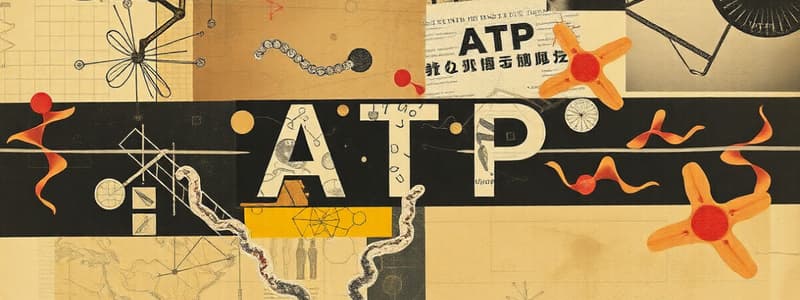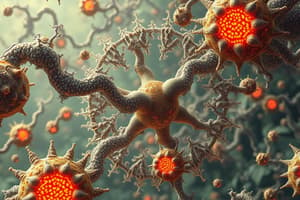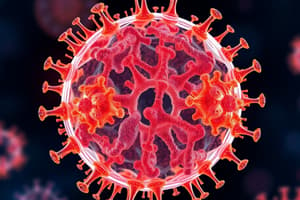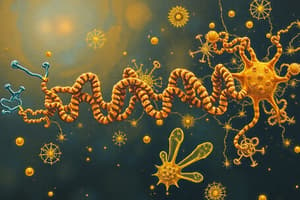Podcast
Questions and Answers
Which statement accurately contrasts catabolism and anabolism?
Which statement accurately contrasts catabolism and anabolism?
- Catabolism releases energy, while anabolism requires energy. (correct)
- Catabolism synthesizes ATP, while anabolism consumes ATP.
- Catabolism occurs only in animals, while anabolism occurs only in plants.
- Catabolism builds larger molecules, while anabolism breaks down larger molecules.
Consider a reaction where the free energy of the products is higher than the free energy of the reactants. What type of reaction is this, and what does it require?
Consider a reaction where the free energy of the products is higher than the free energy of the reactants. What type of reaction is this, and what does it require?
- Endergonic; requires the release of energy.
- Exergonic; requires an initial input of energy.
- Exergonic; requires the release of energy.
- Endergonic; requires an input of energy. (correct)
What is the primary role of ATP in cells?
What is the primary role of ATP in cells?
- To provide energy for cellular processes. (correct)
- To transport molecules across cell membranes.
- To catalyze metabolic reactions.
- To store genetic information.
How does the breakdown of ATP into ADP and inorganic phosphate contribute to cellular processes?
How does the breakdown of ATP into ADP and inorganic phosphate contribute to cellular processes?
What is the direct result of an exergonic reaction?
What is the direct result of an exergonic reaction?
How do cells typically utilize the energy released by exergonic reactions?
How do cells typically utilize the energy released by exergonic reactions?
What best describes the relationship between ATP, ADP, and energy in a cell?
What best describes the relationship between ATP, ADP, and energy in a cell?
In cellular metabolism, how are endergonic reactions typically driven or facilitated?
In cellular metabolism, how are endergonic reactions typically driven or facilitated?
A scientist observes a metabolic pathway that results in the synthesis of a complex protein from multiple amino acids. Which type of process does this best represent?
A scientist observes a metabolic pathway that results in the synthesis of a complex protein from multiple amino acids. Which type of process does this best represent?
Following an intense workout, muscle cells break down glucose to produce ATP. What best describes this process?
Following an intense workout, muscle cells break down glucose to produce ATP. What best describes this process?
How does the instability of ATP contribute to its role as the cell's primary energy currency?
How does the instability of ATP contribute to its role as the cell's primary energy currency?
What happens to the free energy during an exergonic reaction?
What happens to the free energy during an exergonic reaction?
What role do exergonic reactions play in the ATP cycle?
What role do exergonic reactions play in the ATP cycle?
If $\Delta G$ for a reaction is negative, what does this indicate about the reaction?
If $\Delta G$ for a reaction is negative, what does this indicate about the reaction?
In the context of cellular metabolism, what is meant by 'coupled reactions'?
In the context of cellular metabolism, what is meant by 'coupled reactions'?
Which of the following reaction types is most directly involved in the synthesis of proteins from amino acids?
Which of the following reaction types is most directly involved in the synthesis of proteins from amino acids?
If a cell has a high energy demand, what change would you expect to see in the ATP cycle?
If a cell has a high energy demand, what change would you expect to see in the ATP cycle?
How does the structure of ATP relate to its function as an energy carrier?
How does the structure of ATP relate to its function as an energy carrier?
What is the ultimate fate of the energy released during exergonic reactions in a cell?
What is the ultimate fate of the energy released during exergonic reactions in a cell?
Which of the following statements accurately reflects the role of ATP in the coupling of exergonic and endergonic reactions?
Which of the following statements accurately reflects the role of ATP in the coupling of exergonic and endergonic reactions?
What distinguishes anabolism from catabolism?
What distinguishes anabolism from catabolism?
What is the role of free energy in a chemical reaction?
What is the role of free energy in a chemical reaction?
How is ATP's structure suited to its function as an energy currency?
How is ATP's structure suited to its function as an energy currency?
What type of reaction is the synthesis of glucose from carbon dioxide and water during photosynthesis, and what are its energy requirements?
What type of reaction is the synthesis of glucose from carbon dioxide and water during photosynthesis, and what are its energy requirements?
Which process is most likely to be coupled with the hydrolysis of ATP?
Which process is most likely to be coupled with the hydrolysis of ATP?
If a reaction decreases the entropy within a system, what else must be true for the reaction to be spontaneous?
If a reaction decreases the entropy within a system, what else must be true for the reaction to be spontaneous?
An organism's metabolism is best defined as:
An organism's metabolism is best defined as:
How does the breakdown of glucose contribute to the ATP cycle?
How does the breakdown of glucose contribute to the ATP cycle?
What is the primary role of catabolic pathways in the context of cellular energy?
What is the primary role of catabolic pathways in the context of cellular energy?
Flashcards
Cellular Metabolism
Cellular Metabolism
The sum of all chemical reactions occurring in a cell.
Catabolism
Catabolism
Reactions that break down large molecules into smaller ones.
Anabolism
Anabolism
Reactions that make large molecules from smaller ones.
Free Energy
Free Energy
Signup and view all the flashcards
Exergonic Reactions
Exergonic Reactions
Signup and view all the flashcards
Endergonic Reactions
Endergonic Reactions
Signup and view all the flashcards
ATP
ATP
Signup and view all the flashcards
ADP
ADP
Signup and view all the flashcards
Study Notes
- Chapter 5 focuses on metabolism, energy, and enzymes.
- Section 5.1 specifically covers energy transformations and metabolism.
Metabolism
- Metabolism is the sum of all chemical reactions within a cell.
- Catabolism involves breaking down large molecules (products) into smaller molecules (reactants).
- Anabolism involves creating large molecules (products) from smaller molecules (reactants).
Energy and Reactions
- Free energy represents the energy available after a chemical reaction.
- The change in free energy (ΔG) is calculated as free energy of products minus free energy of reactants.
- A negative ΔG indicates products have less energy than reactants, favoring the reaction.
- Exergonic reactions are spontaneous and release energy.
- Endergonic reactions require energy input.
- Cells often use energy from exergonic reactions to power other reactions.
ATP
- ATP is the primary energy currency of cells.
- ATP is synthesized from ADP and inorganic phosphate.
- Energy is released when the bond on the terminal phosphate of ATP is broken.
- This released energy powers endergonic reactions within the cell.
Studying That Suits You
Use AI to generate personalized quizzes and flashcards to suit your learning preferences.




